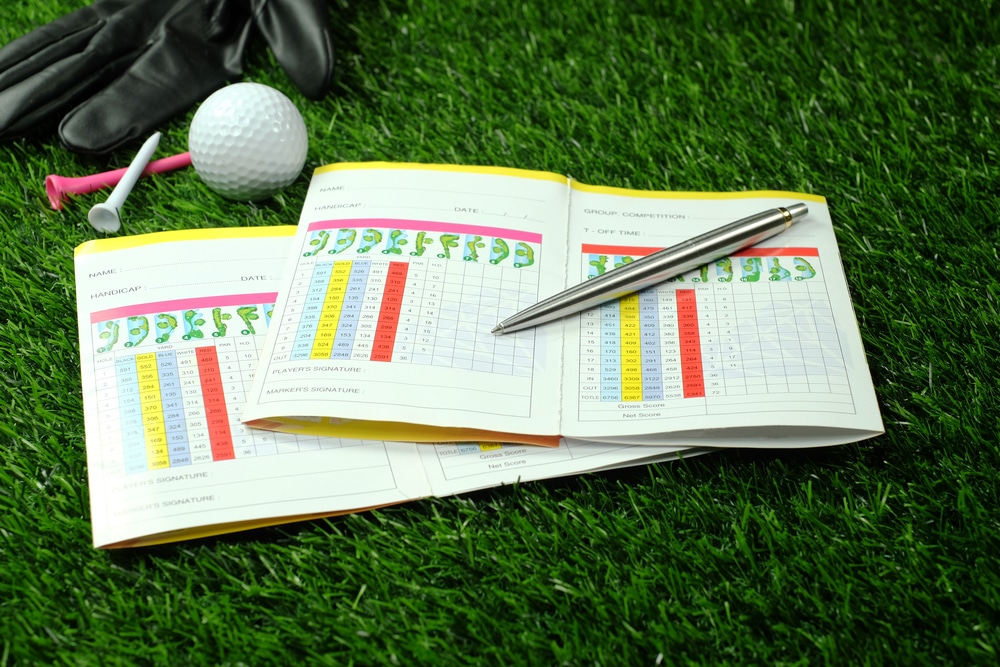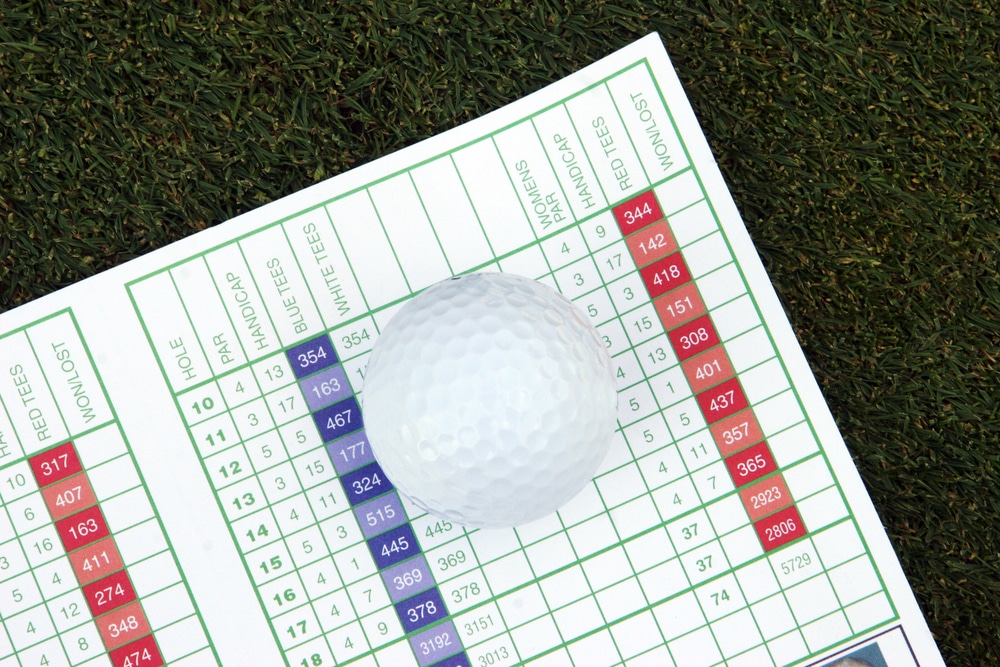
So.. What’s the score, guys? You must constantly look at your golf scorecard for the score if you’re a professional player. But do you actually know how to read your golf score? Understanding what golf is before actually getting into the sport is necessary. Just like knowing the golf club names, knowing your net score is also crucial. Now, you must also be wondering where to get the proper idea of the scorecard. You don’t have to look any further, as we will explore the knows and hows of golf club scoring rules. Whether you’re just a beginner who wants to know how to read a golf scorecard or an enthusiastic sportsperson who wants to learn the basics, all your answers are here.
Scoring in Golf
What exactly is a golf scorecard symbol? Moreover, what is its significance in the gameplay? A golf scorecard is an essential piece for the game, acting as a player’s strategic guide in addition to keeping score. It helps players plan their approach based on the course layout by providing information on each hole’s number, par, and distance from different tee boxes. The game is competitive across skill levels because players keep track of their strokes per hole, making calculating gross and net scores (total strokes easier). The scorecard also frequently has the course and slope ratings, showing how challenging the course is for scratch and double bogey players. This extensive scoring card is essential for monitoring performance and understanding the nuances of every game played.

A Study of the Golf Scorecard
Now, let us first decode the complete anatomy of a golf scorecard template and how it works.
The golf scorecard is a vital instrument that helps players navigate the course and provides important information and strategic insights.
- Hole Numbers: The game’s sequence is arranged using hole numbers, split into the front and back nine and ranging from 1 to 18. This layout allows players to navigate the course more easily and control the game’s flow.
- Par: Each hole’s par tells players of the typical strokes an expert would use, setting performance expectations. This aids in establishing objectives and determining skill levels as the round progresses.
- Handicap: Each hole has a handicap number that indicates the degree of difficulty. This allows players of different skill levels to compete fairly, making the game more equitable. Knowing which holes are the hardest can affect how a golfer plays them.
- Yardage: The indicated tee-to-green distances guide club selection and shot placement. Different tee boxes offer suitable difficulties for different skill levels, greatly impacting strategy.
- Tee Colors: By classifying launch points according to player characteristics like age, gender, and talent, tee colors ensure each player plays from a position that best suits them, increasing fun and competitiveness.
Course and slope ratings quantify a course’s difficulty. The course rating indicates a scratch golfer’s anticipated score, while non-scratch golfers’ scores vary according to the slope rating. Being aware of these can modify players’ expectations and strategies.
How to Read Golf Scorecard?
Various procedures are involved in accurately and legally keeping track of your game when reading and marking a golf scorecard. Firstly, Locate the column that contains holes 1 through 18. First, there is a blank golf scorecard, and then numbers are added.
- Separate the Front and Back 9: Identify the Front 9 (holes 1–9) and Back 9 (holes 10–18), designated as Out and In, respectively, to indicate how the play is directed about the clubhouse.
- Verify the Tee Box Distances: Take note of the distances shown under the different color names on the scorecard. Professionals (black or gold) and distances to the green should use different tee boxes represented by distinct colors.
- Handicap Indexes: Find the index next to each hole, which ranges from 1 (the hardest) to 18 (the easiest). This information is crucial for making modifications during match play.
- Par Information: Note each hole’s par number, which represents the anticipated number of strokes a proficient player should use.
- Initials of the Player: List each player’s name or initials, up to four.
- Keeping Score: Keep track of how many strokes every player makes on each hole.
- Fix Errors: If a score is entered erroneously, cross it out and indicate the right score next to it.
- Summarize Scores: Add the sum of the Front and Back 9 scores to the total score for the round.
- Sign the Scorecard: Once you have verified that all the scores are accurate, sign the scorecard to attest to its accuracy.
By following these instructions, you may be confident that your golf scorecard accurately captures the game that was played. Moreover, you can also use Mscorecard to help you understand your score better.

Scorecard for Game Strategy
A golf scorecard is a useful aid that improves gameplay by offering in-depth information about the course.
- Course Layout Analysis: Recognize Difficulties; Take note of elements like dangers and doglegs.
- Plan Your Strokes: Choose your clubs according to the yardage and par of each hole, whether it’s a par 3 hole or any other.
- Control Energy: Determine which holes are harder in order.
- Selecting Appropriate Sets of Tees: Make sure to select appropriate white tees or red tees.
- Match Skill Level: Pick tees that are appropriate for your level of skill.
- Make the Necessary Adjustments: Choose your tees based on your area of interest (long drives or short games).
- Adjust to Circumstances: Take the path and weather into account.
- Determine Difficulty: Lower handicap numbers indicate more difficult holes.
- Strategic Play: Determine when to play aggressively by using a handicap system.
- Analyze Your Performance: Find your strengths and shortcomings by reviewing how you performed in each hole of the course.
Common Mistakes to Avoid
A few typical mistakes can be made when handling a golf scorecard, which could negatively impact your game experience and scoring precision.
- Math Errors: Addition errors can drastically affect your score. Always double-check your math to avoid this, or even better, use a computerized scoring program that does the numbers and lowers the possibility of human error.
- Ignoring Hole Changes: If temporary modifications to a course are not considered, they may impact your grade. To ensure the accuracy of your scorecard explanation, always ask the course workers whether there have been any layout adjustments before you begin your round.
- Misinterpreting Course Ratings: It’s important to know the difference between difficulty and course rating. The course rating does not necessarily indicate how difficult the course is; rather, it is intended to represent the predicted score for a scratch golfer. Take a look at the slope rating to get an idea of how difficult it is for non-scratch players.
Keeping an eye on these details can help you handle your scorecard more skillfully and have a more precise and conflict-free round of golf.

Final Thoughts ⛳
Summing up. for every player hoping to become an expert in the game, comprehending the golf scorecard is as crucial as having a flawless day on the links. During our investigation, we have learned how to interpret and use these cards effectively, understanding everything from basic scores to intricate course specifics. Whether taking on an 18-hole match or figuring out the ins and outs of a mini-golf scorecard, golfers can improve their game and make the most of every round by using their knowledge of golf scorecards or disc golf scorecards.
In conclusion, the scorecard is an essential component of golf that provides clarity and strategic depth, not merely a tool.
SCORE BIG!





